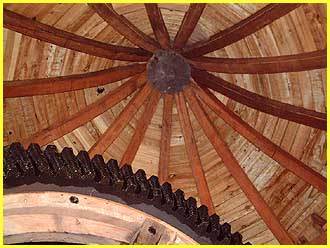Guest Page No. 4
More From Close To Home
Heage Windmill
|
 November
2004 - Earlier this year I visited the windmill at Heage
and showed several photos from there elsewhere on this site -
click here
to view. Since then, one of the volunteer guides who works
at the mill has contacted me sending a number of images that
have been taken on the dust floor of the mill where visitors
are not normally allowed for safety reasons. A Fuji 4900 x 6
zoom camera was used to capture the images and all the information
that accompanies them has also been provided by the photographer. November
2004 - Earlier this year I visited the windmill at Heage
and showed several photos from there elsewhere on this site -
click here
to view. Since then, one of the volunteer guides who works
at the mill has contacted me sending a number of images that
have been taken on the dust floor of the mill where visitors
are not normally allowed for safety reasons. A Fuji 4900 x 6
zoom camera was used to capture the images and all the information
that accompanies them has also been provided by the photographer.
All images are copyright protected and used with permission.
|

This image shows one of the six truck wheels that run
on the inside of the curb and help keep the mill cap centralised.
|

This view is looking up beyond the gear on the dust floor to
the apex of the wooden O'gee cap.
|

This is the hoist that raises the sacks of corn to the
Bin Floor. It is friction driven from a wheel rubbing on the
underside of the wallower gear, the wallower being the gear that
changes the rotation of the wind shaft from horizontal to vertical.
|

Disaster would strike if the sails were not kept in the correct
position and this shows a few of the gears involved in the drive
train from the fantail. This drive rotates the cap and keeps
the sails facing into the wind.
|

The sails of the mill, despite appearances from a distance, are
not solid but are made up of a number of shutters. This close
up shows the rotating end of the striking gear. This rod passes
through the centre of the hollow windshaft and it is this mechanism
which allows the miller to control the angle of the sail shutters.
|

The Society for the Protection of Ancient Buildings (SPAB) is
a national body that has been giving awards since 1991 for outstanding
restoration, involvement of the local people and the ability
to carry out maintenance in the future to the present standard.
To date very few have been awarded but Heage Mill has been the
proud recipient of No. 12.
|
The mill is closed for winter maintenance/improvements
and at the time of writing a new spring loaded leather wiper
is being made to ensure that the flour which spills out of the
millstones circumference is taken around the receiving track
and into the floor exit hole. When the mill is working it is
not possible to see the wiper as it is covered by the wooden
tun but when the mill re-opens next year I'm sure it will be
in tip top condition. You can find out more about the mill here.
|